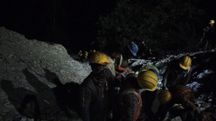It’s science, not plastic: Sikkim Milk clarifies viral 'curdling' controversy
A viral video showing what appeared to be curdled milk from the Sikkim Co-operative Milk Producers' Union Limited (Sikkim Milk) has sparked widespread alarm and confusion on social media.

A viral video showing what appeared to be curdled milk from the Sikkim Co-operative Milk Producers' Union Limited (Sikkim Milk) has sparked widespread alarm and confusion on social media.
The footage, posted by the account Vimagar Vlog, shows a packet of Sikkim Milk curdling into clumps, which some viewers mistakenly interpreted as a contamination or plastic-like substance in the milk. This video has raised several questions about the quality of milk from the Union and the safety of consuming its products.
In response to growing concerns, Sikkim Milk Union has issued a detailed clarification, addressing the issue head-on. The Union confirmed that the milk in question, which was packaged on April 15, 2025, is indeed one of their products.
However, the company clarified that the milk had passed its "Use By" date by the time it was shown in the video, leading to the curdling process. According to the Union, once milk passes its "Use By" date, it is more susceptible to spoilage due to microbial activity, even if it was initially pasteurized.
The Sikkim Milk Union further elaborated that improper storage conditions before and after purchase can contribute to early spoilage, which accelerates the curdling of milk. They urged consumers to pay attention to the expiration date and ensure proper refrigeration to avoid similar incidents.
"We fully understand the concerns raised by our consumers, and we take full responsibility for providing transparent information about the situation," said Dr. Pradhan, the Joint General Manager of Sikkim Milk Union. "We would like to assure everyone that the milk shown in the video was not unsafe, but rather a result of exceeding the 'Use By' date, which is a natural part of the spoilage process."
Milk curdling or the appearance of clumps in milk is often misunderstood, leading many consumers to believe the milk is contaminated. However, experts explain that this curdling is a natural process linked to the spoilage of milk, especially after it has passed its expiration date. The Sikkim Milk Union’s response offers a deeper scientific understanding of the issue, helping to clear up the confusion.
Also Read: Sikkim devotees embrace divine at Namchi's Siddheshwar Dham
The curdling seen in the video was primarily caused by the activity of psychrotrophic and thermoduric bacteria, which are types of bacteria that can survive pasteurization or contaminate milk after processing. These bacteria produce enzymes that break down the milk’s proteins and fats, leading to the clumping and curdling effect when the milk is heated. While pasteurization kills most harmful bacteria, these resilient bacteria can still cause spoilage if the milk is stored improperly or kept too long after its expiration.
According to the Union, when milk is stored at the wrong temperature, especially in warmer conditions, it speeds up bacterial growth and enzymatic reactions, resulting in faster spoilage. This can happen even before the expiration date if the milk is exposed to improper storage conditions during transport or at retail outlets.
Another aspect of the video that caught viewers’ attention was the appearance of "plastic-like" materials in the curdled milk. This led some to speculate that the milk might have been contaminated with plastic. However, scientific analysis provides alternative explanations for these clumps that may appear rubbery or "plastic-like."
There are two primary scientific explanations for the plastic-like appearance in milk:
Casein Clumping: Milk contains a natural protein called casein, which, when exposed to acid or heat, can form curds. This process is similar to how cheese is made. In spoiled milk, the proteins coagulate and form clumps, which can sometimes resemble plastic when they become denatured due to heating. Historically, casein plastic was used to make items such as buttons, ornaments, and jewelry, which might explain why some people mistakenly believe the curds are plastic.
Another explanation for the appearance of "plastic-like" material could be the formation of milk skin. When milk is heated, proteins and fats can separate, forming a thin, edible layer on the surface. This skin can resemble plastic in texture, but it is actually made of coagulated proteins and fats.
There is also a growing concern about microplastics, which are tiny plastic particles that can be found in food and water. However, experts stress that the presence of microplastics in milk is a different issue altogether and requires laboratory analysis to confirm. No evidence has been provided that suggests the Sikkim Milk in the video was contaminated with microplastics.
While the Sikkim Milk Union has clarified that the curdling was a result of expired milk, the company also offered helpful tips to ensure that consumers always receive fresh, safe milk. They emphasized that checking the "Manufacture Date" and "Use By Date" is the most important step in ensuring that milk is consumed before it starts to spoil.
The Union advised consumers to follow these simple steps:
1. Check the dates: Always verify the "Manufacture Date" and "Use By Date" before purchasing milk.
2. Store milk properly: Milk should always be kept under proper refrigeration at or below 4°C (40°F). Ensure that it is not left out at room temperature for extended periods.
3. Consume before expiry: While pasteurized milk remains safe for consumption up until its "Use By" date, it should be consumed as soon as possible to maintain its freshness and quality.
4. Handle with care: Ensure that milk is handled properly during transport and at home. Exposure to high temperatures or improper handling can cause premature spoilage.
The incident involving the viral video has brought to light the importance of understanding the factors that contribute to milk spoilage. Sikkim Milk Union reassured the public that its products meet high standards of quality and safety, and that the curdling seen in the video was merely a result of expired milk.
The Union also encouraged any consumers with concerns or queries about the issue to reach out for further clarification. They remain dedicated to offering safe, fresh dairy products to the people of Sikkim and beyond.
Copyright©2025 Living Media India Limited. For reprint rights: Syndications Today









